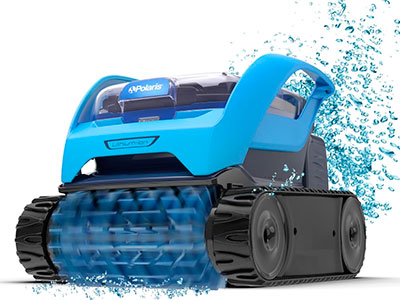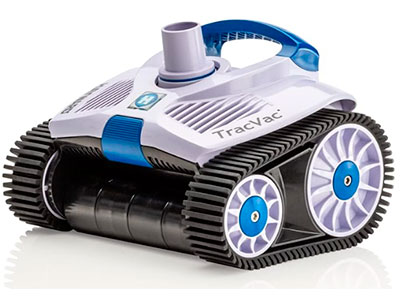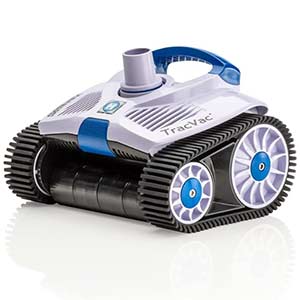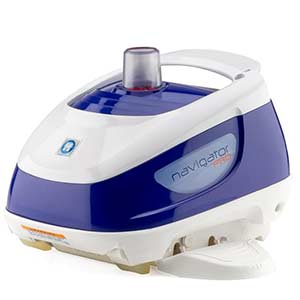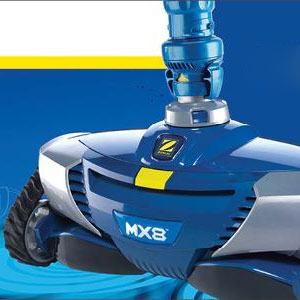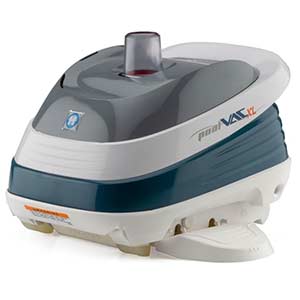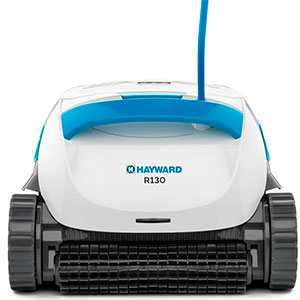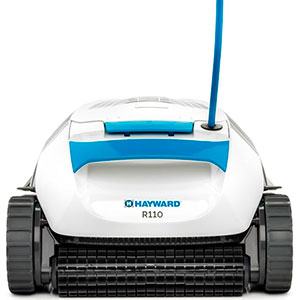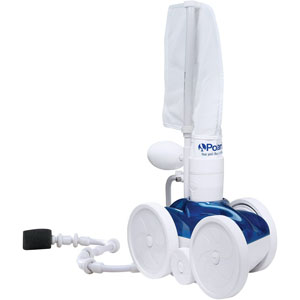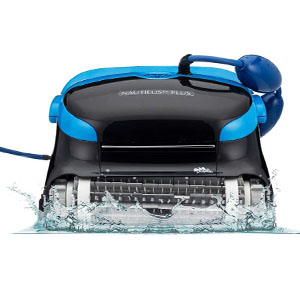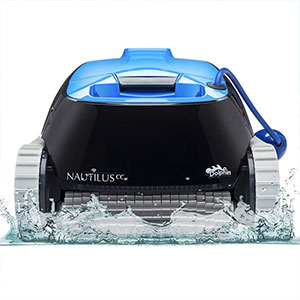Polaris Pixel vs. Hayward Tracvac – Comparison review
Automatic pool cleaners are recommended devices for relaxed pool maintenance in automatic mode. They may clean walls, floors, and waterlines, filter the water, and decrease the load on the pool pump and filter. Together, this equipment ensures crystal clear water safe from organics to refresh on hot sunny days. If you like autonomous devices for cleaning your pool, we can also recommend solar skimmers and chlorinators to keep the required water pH level. The market proposes devices for each budget, pool type, and size.
In this article, we collected descriptions of the pros and cons of two cordless compact cleaners, Polaris Pixel vs. Hayward Tracvac. You will find out the benefits of different types of pool cleaners, what maintenance is required, and which model to choose for your swimming pool. You will also clarify their capabilities and why their prices differ. Both cleaners are produced by reliable companies with long histories and a large number of service centres all over the world.
Polaris Pixel vs. Hayward Tracvac – Comparison table
2. Main differences between models
Surprisingly, between these two compact cleaners with similar appearance, there are more differences than similarities. The main differences are:
- Polaris Pixel Compact is a robotic pool cleaner, while Hayward TracVac is a suction-side pool cleaner.
- Polaris Pixel Compact does not require any installation; it works without cords and cables (use the rechargeable battery). While Hayward TracVac should be connected to the suction side of your pool pump using hoses and adapters from the package.
- Polaris Pixel has a scrubbing brush; Hayward TracVac does not have brushes.
- Polaris Pixel works autonomously without connection to the pool systems, while Hayward TracVac should be connected to the pool filter and pump.
- Hayward TracVac can clean walls and floor, but Polaris Pixel cleans only the floor.
The more detailed face-to-face comparison we provide in the Buyer’s Guide.
3. Detailed product review
Polaris Company has been producing pool equipment for more than 50 years. You can choose between corded and cordless models for every budget and smart feature. Cordless cleaners are Polaris Freedom and Polaris Pixel only. At the same time, Hayward is one of the first product brands among U.S. Pool professionals with nearly 100 years of history. It produces about 20 different pool cleaners.
Polaris Pixel Compact Cordless Robotic Pool Cleaner
Polaris Pixel is a compact cordless robotic cleaner for floor cleaning. It is designed for all types of above-ground pools and simple in-ground cleaners with depths from 15 inches to 13 feet. The recommended operating water temperature is 55 F to 95 F. The robot has a front PVC scrubbing brush with a “wear” indicator. You need to replace it in a timely manner for excellent performance. For moving on the floor, Polaris Pixel has truck wheels on both sides.
It has only one cleaning mode for the floor, which is 90 minutes long. The charging time is three hours. In the package, the charger, which works from a GFCI outlet, is included. To charge the cleaner after each cleaning cycle, you need to take it out from the water with a removal hook or floating leash and dry the cleaner and charging contacts. Charging contacts during cleaning are protected with a protective cap. Also, you need to clean the filter canister every time. The LED indicator on the body informs about battery status – blinking orange shows battery charging, blinking red is a problem, and solid green shows a fully charged battery that runs a full cycle. To protect the battery, the cleaner, after eight days of inactivity, goes to sleep mode.
To start the robot, you need to press the power switch button. The cleaning cycle will start only when the cleaner detects water and is fully submerged. The filter canister has top access for easy removal and cleaning. During cleaning, you can check the filter canister through the transparent lid. Cyclonic vacuum technology ensures strong suction during the whole cleaning cycle and captures all debris and dirt in the filter canister. It should be cleaned with a hose and periodically with soapy water and a soft bristle brush.
- Simple control only with one button
- Cordless compact design
- Easy clean large filter canister
- Automatic wall-side parking for easy extract
- Transparent canister lid
- Long cleaning cycle for 90 minutes
- LED status indicators
- Cyclonic vacuum technology
- Floating leash to assist in removal
- Charging time less than three hours
- Expensive
- Only floor cleaning
- Only indoor storage
- Should be fully dried before charging
- No smart features
Hayward TracVac Lightweight Automatic Suction Vacuum Cleaner
Hayward TracVac is a compact suction-side automatic pool cleaner. It has robust track wheels to climb all drains and uneven surfaces on all types of pool surfaces. It can clean the walls up to the waterline and steps if it has enough angle and radius. The automatic cleaner has a programmed steering system to cover the whole pool floor and turn and move according to six programs. The leading hose with two floats ensures free turning without tangling. The hollow turbine is responsible for the suction of all debris into the pool filter.
Hayward TracVac is connected to the dedicated suction port or the skimmer; you should think about connection capabilities during pool construction. If you have only a skimmer, then you need to insert into the port there a hose cone adapter, flow regulator valve and knob (all parts are included in the package). You need to install the first section of the hose into the flow regulator valve. If you have a special separate port, you need to insert the same pieces into the skimmer, but instead of the hose, install a regulator cap there. The first section of the hose should be installed through the safety Vac-Lock (not included). You have 12 pieces of hoses in the package, creating a total length of 38.83 ft.
The important notice for TracVac users is that you need to prepare a pool before the cleaner enters. You need to remove manually large and excessive debris, backwash or clean the filter cartridge, empty the skimmer and pump baskets, and check the pH balance (pH – 7.2-7.8; chlorine 1.0-3.0 ppm, total alkalinity 80-120 ppm). Moreover, return fittings should be pointed downwards for maximum pool coverage. The cleaner’s turbine should be checked for stuck debris, and the pool system should keep the maximum flow.
- Leader hose with two floats to prevent hose tangling
- Adjustable hose length
- Patented track wheels for better maneuverability
- Light weight
- No charging or batteries is required
- Flow gauge to check water flow
- Easy construction for maintenance
- Two options for connection – a skimmer or a port
- Floor and wall cleaning
- Works from pool pump
- Before start of usage pool preparation is required
- Requires installation
- Safety Vac-Lock fitting is not included in the package
- No scrubbing brush
- Do not have own filter basket
4. Buyer’s Guide
Our comparison describes two automatic pool cleaners of different pool types. To make the review clearer about the differences between these cleaners, we want to provide a short comparison in this section. There are three types of automatic pool cleaners: pressure–side, suction–side, and robotic pool cleaners. All of them can perform cleaning automatically without human guidance. All manual cleaners require guidance from humans and some physical effort.
| Pressure-side cleaners | Suction-side cleaners | Robotic pool cleaners | |
|---|---|---|---|
| Pros |
|
|
|
| Cons |
|
|
|
Among automatic pool cleaners, suction-side cleaners and robotic pool cleaners seem preferable. But please take into account that not all models have all these pros and cons listed in this table; we summarized features. Below, the face-to-face comparison of Polaris Pixel vs. Hayward Pixel shows the exact differences between the two automatic pool cleaners in addition to those listed in the main differences section.
Design
Hayward TracVac has a white body (8.9 x 7.9 x 11.3 inches) with a large blue handle for taking into and out of the water. The model is very light for convenient maintenance and use (6 lbs). From both sides, the cleaner has four plastic wheels with tracks.
The connection port to the hose is located on the top. From one side, the hose should be connected to the cleaner, and from another to the dedicated suction port or a skimmer. The lid has a blue buckle for quick opening and taking out the debris stuck in the turbine or gears.
Hayward TracVac is a compact model that is much smaller than Polaris Pixel. If you need a model with simple construction and lightweight, the TracVac is the winner. However, TracVac is also a fully dependable model compared to other pool equipment.
Installation
Hayward TracVac should be connected to the dedicated port or the skimmer, using all fittings and hoses. The robot can’t work without a connection to the pool equipment.
Polaris Pixel is the winner in the Polaris Pixel vs. Hayward TracVac comparison, as it does not require installation.
Control
Hayward TracVac works from the pool pump; while it is on, the cleaner can work. You need to submerge the cleaner while the pump is off. Then, you need to connect all hoses, check the pool equipment, and start the pump.
There is no winner in this round, as neither device has a remote control. You can turn off the TracVac by turning off the pool pump, while Polaris Pixel needs to be extracted from the water.
Filter
Hayward TracVac does not have its own filter. All collected debris goes to the bottom suction port and hoses to the pool filter. You may install an additional leaf canister on the hose (purchased separately).
Polaris Pixel is the winner, as it has a separate filter canister, reducing the load on the pump filter.
Charge

Hayward TracVac does not need batteries or cords for work.
Hayward TracVac is the winner because it does not need to be charged and does not use additional energy.
Cleaning cycle
- Polaris Pixel has 90-minute cycles to clean the pool floor.
- Hayward TracVac does not have a determined cleaning cycle. It works until you stop it when you consider that the pool is clean or you want to use it for swimming or normal water filtration/maintenance.
Polaris Pixel is the winner, as you have a fixed cleaning cycle, and the cleaner will stop after it. The Hayward TracVac should be stopped manually. You can stop abruptly both cleaners.
The only similarity between the two cleaners is that they have only one cleaning automatic mode, which ensures the full coverage of pool surfaces (walls and floor—Hayward TracVac, floor—Polaris Pixel).
5. How to choose an automatic pool cleaner?
The previous parts of this article have shown that there are more differences in the compared items Polaris Pixel vs. Hayward TracVac than similarities. The main reason for that is that Polaris Pixel is robotic pool equipment that can work autonomously, while Hayward TracVac is a dependable suction side cleaner. To finalize your choice between these two models, we propose to go through a questionnaire to determine the most suitable model for your swimming pool:
If you have a tough budget, Hayward TracVac is a preferable solution because of the cheaper initial costs. Considering the expenses on electricity, you anyway use your pool pump additionally to the main cycle, almost the same time as you charge the battery.
6. Frequently Asked Questions (FAQs)
1. What is the recommended distance for charging the Polaris Pixel installation?
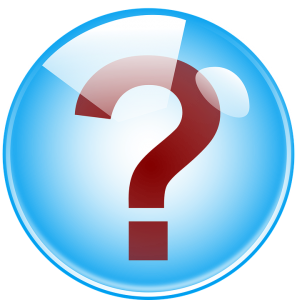 You need to charge the dry Polaris Pixel after each cycle. It is not recommended to use the extensions from the GFCI outlet to charging ports, only the charging adapter from the package. The robot should be installed from 11.5 ft from the swimming pool edge.
You need to charge the dry Polaris Pixel after each cycle. It is not recommended to use the extensions from the GFCI outlet to charging ports, only the charging adapter from the package. The robot should be installed from 11.5 ft from the swimming pool edge. 2. Why is Polaris Pixel bubbling during submerging?
3. Why does my Hayward TracVac not climb the walls?
4. What is the purpose of small black plastic pipes on both sides of Hayward TracVac?
5.How often should I change tires on the Hayward TracVac?
Conclusion
In the comparison of Polaris Pixel vs. Hayward TracVac, there is no obvious winner. Some owners prefer suction-side pool cleaners, as they do not need to charge them, and they are simple to maintain with moving parts. Hayward TracVac is simple to install and increases the load on pool equipment, but it works efficiently in collecting all types of debris. Polaris Pixel can clean only the floor and cove but does not need any installation and does not have cables and hoses. It has a separate filter basket with a transparent lid and is easy to clean. If you need a cordless model with a fixed cleaning cycle, then Polaris Pixel is a good choice, but you will be limited only to floor cleaning. So, there are pros and cons to each model based on the comparison. We tried to explain all the features and capabilities of these automatic robotic cleaners to help you make a good choice.




